If your business is looking into how to implement a winning B2B SEO strategy, you’ve come to the right place.
When thinking about how to increase organic traffic to your business, you need to be in the mindset that people are the ones searching, not businesses.
If you can find out the exact search terms your target audience is using when searching, and you can create great content that meets their needs, you’ll be able to put your business in a position to start driving tons of inbound leads from Google and other search engines.
This comprehensive guide will teach you how to properly start increasing your organic search traffic, and how you can then turn those targeted visitors into leads for your business.
Search engine optimization (SEO) is the process used to rank your web pages in search engines such as Google.
SEO is important to B2B brands because by ranking important pages in search, you’ll be able to reach professionals that are searching for your products and/or services.
Some examples of this would be the following scenarios:
Assume for a second that you’re a SaaS business that provides invoice management software in a wide array of industries.
You’re going to want to get in front of these searches and showcase your service and all of its benefits.
When it comes to SEO, we can group most activities into three different categories:
On-Page SEO heavily deals with all of the content on your website that you’re providing to your users and the rankings factors that go into making your website be found in the search engine results page.
Some sub-categories would include keywords, title tags, meta descriptions, h1 tags and even user experience.
All of these make up the factors on your website that will be responsible for helping you to rank in Google and other search engines.
Off-Page SEO includes all of the ranking factors external to your website that help you to rank.
This includes backlinks and link building, anchor text, and social media marketing.
Technical SEO looks at your website structure and includes page speed, schema, SSL, and mobile-friendliness.
Technical SEO really comes more in the picture when we’re talking about very large sites, and sites running on eCommerce platforms.
If you’re running on WordPress for example, normally there’s not too much to worry about when it comes to Technical SEO.
When we look at SEO in the most simplistic terms, it’s all about reaching your target audience through search by optimizing your website for search engines.
Doing so focuses on the three essentials:
With that being said, there are a few differences when comparing B2B SEO vs. B2C SEO.
When working on B2C keyword analysis, you’ll often notice that many keywords have very-high search volumes.
For example, the keyword “car dealer near me” gets over 13,000 searches per month:
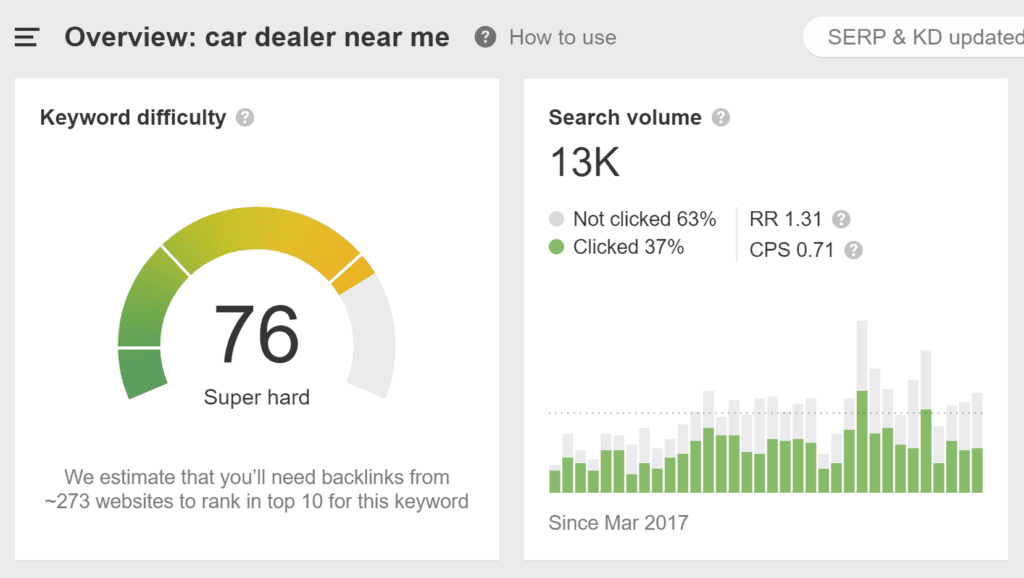
But take the keyword “automotive dealer software” which sees only 300 searches per month.
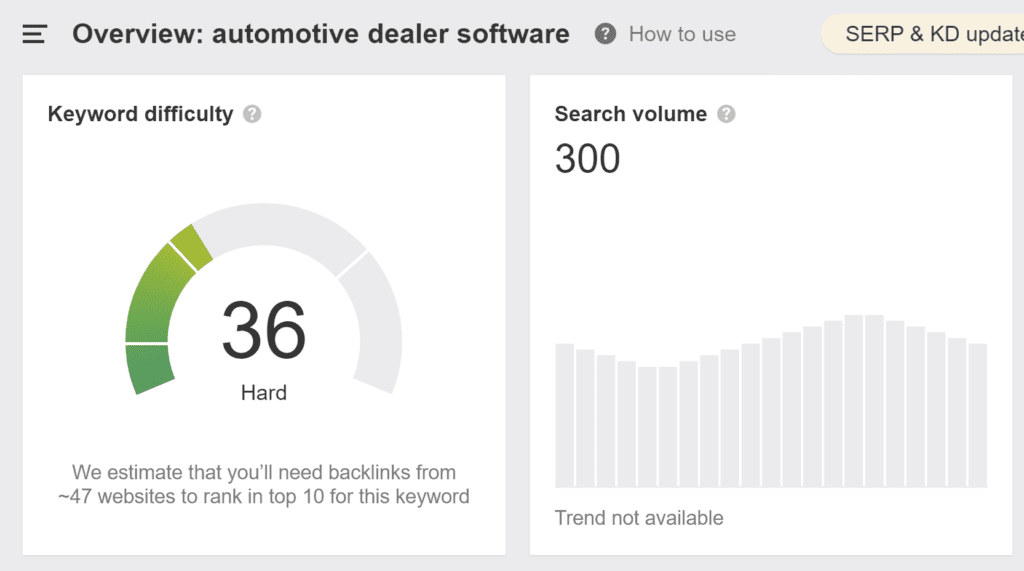
B2B keywords see a much lower search volume than keywords in the B2C space.
And that’s perfectly fine.
In B2B SEO, keywords with just 10-20 searches a month can be extremely valuable in nature just by the value of converting one of those searches into a paying customer.
We actively want to target keywords that convert and are the “money” keywords that are going to drive conversions.
By targeting multiple keywords on landing pages, for example, we can increase the traffic to a page, and target multiple searches all at once.
For B2B SEO, we don’t want to focus on volume, rather we want to focus on hyper-targeted purchase keywords with high-value.
The B2B sales process involves higher prices, more decision-makers, and a longer sales cycle.
The entire lead generation process is a different ball game when compared to B2C.
Understanding the entire decision-making process leading to the buying process is crucial for getting results.
For these reasons, we can expect that organic conversions will not be as high when compared to B2C searches.
There are over 134,000 searches per month in the U.S. alone for the keyword “garage door repair:”
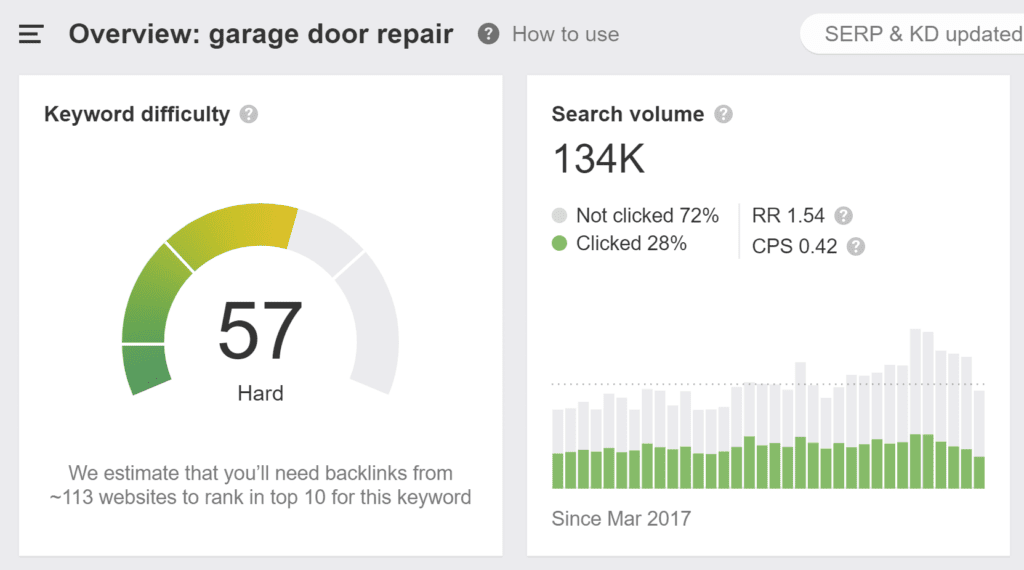
Of those 134,000 searches, at least a few thousand will most likely convert off the first search and find a local garage door repair service in their area either through the local map-pack or the organic search results.
For the keyword “garage doors manufacturer” there’s only 200 searches per month on average in the U.S:
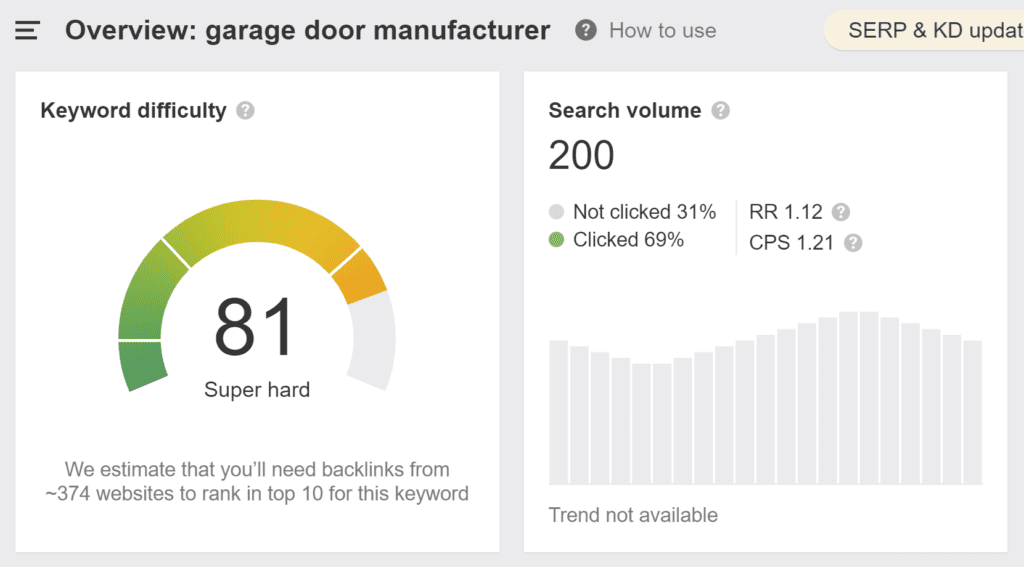
There’s going to be no immediate purchases happening for “garage door manufacturer.”
There’s an entire lengthy sales process to go through working with a vendor, in comparison to B2C, where purchases can happen immediately from the first click.
B2B SEO content should not be built to convert organic visitors directly into sales.
B2B searchers are normally looking for information that can help them better do their jobs.
With that in mind, the objective here is to focus on both providing informational content on the product and/or services, as well as a strong focus on micro-conversions.
Micro-conversions can include newsletter sign-ups, requesting a product demo, or even
B2B products or services are oftentimes much more expensive compared to B2C, with a substantial investment and multiple stakeholders involved in the decision-making process.
Each of these different decision-makers will have different roles and will use different search terms when searching Google.
B2B websites will need to have landing pages set up that answer the questions each of these searchers are querying.
If we take the example of a startup searching for a digital marketing agency to handle their marketing efforts, we’d consider the following roles and their questions:
When implementing a B2B strategy, we must take this into account, and develop a buyer persona for each of these different roles.
The better we can understand and define each of these roles, the more effective our B2B SEO strategy will be.
Writing a B2B marketing strategy for your business can be difficult if you don’t know where to start.
For that reason, we’ve created a step-by-step to guide that you can implement to start driving more organic traffic to your business.
SEO isn’t super complicated, and when we look at what really moves the needle, as always, it’s the three following areas:
That’s it.
With B2B in mind, there are a few other considerations we should keep in mind when developing a strategy specifically for B2B searchers:
When we can answer these three questions, we can begin to put together a strategy that brings SEO results.
The core concept of SEO begins with understanding what your target audience is searching for in Google, Bing, Yahoo, and other search engines.
It’s imperative for you to understand your exact market and who your target audience encompasses.
As mentioned earlier, you’ll need to consider different roles and decision-makers that you’re trying to reach with your marketing efforts.
Once you know who you’re focusing on, then you can narrow down your content strategy to focus on relevant terms to reach these searchers.
In order to understand keywords better and what people are actually searching for, you’re going to need a tool to properly do this.
We always recommend Ahrefs, as it has the most easy-to-use interface and the best keyword tool compared to all other SEO tools out there on the market.
We’re in no way affiliated with Ahres, just a big fan of the tool and the SEO insights that it can provide.
Ahrefs has a 7-day trial, so you’ll want to get signed up in order to dive into the next steps.
Now that you’ve got Ahrefs setup, we’re going to want to take a closer look at keywords your business is already ranking for.
There are two reasons for this:
Open up Ahrefs, and type in the name of your business into the search bar:

On the left-hand menu, click on Organic keywords:

Now you’ll have a list of all keywords your business is ranking for in Google:
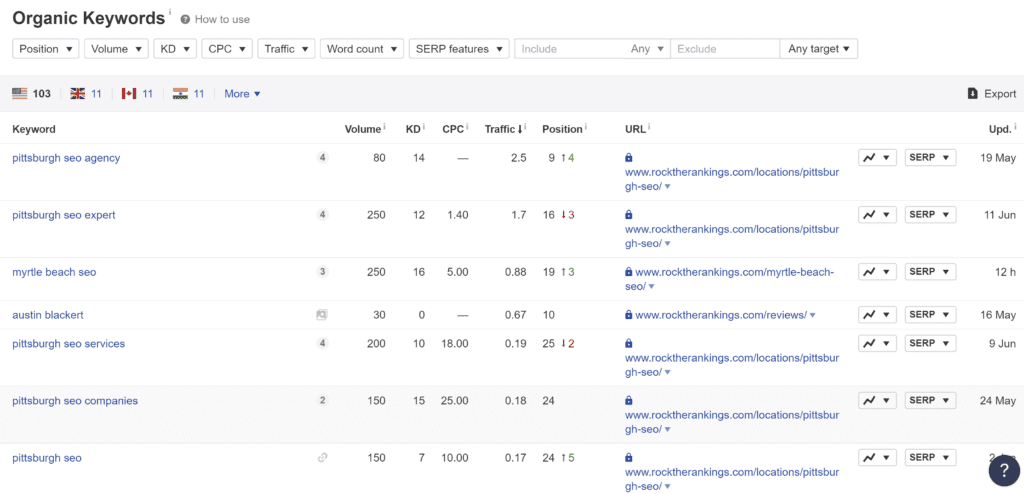
Now you have a great starting point and know what keywords your business is already ranking for, and which pages could use some improvements to help drive them up in the rankings.
You probably already have a rough idea about a search query or two that other B2B companies might be searching for to find your product or service.
Let’s take an example keyword of “learning management system” and drop that into Ahrefs Keyword Explorer:
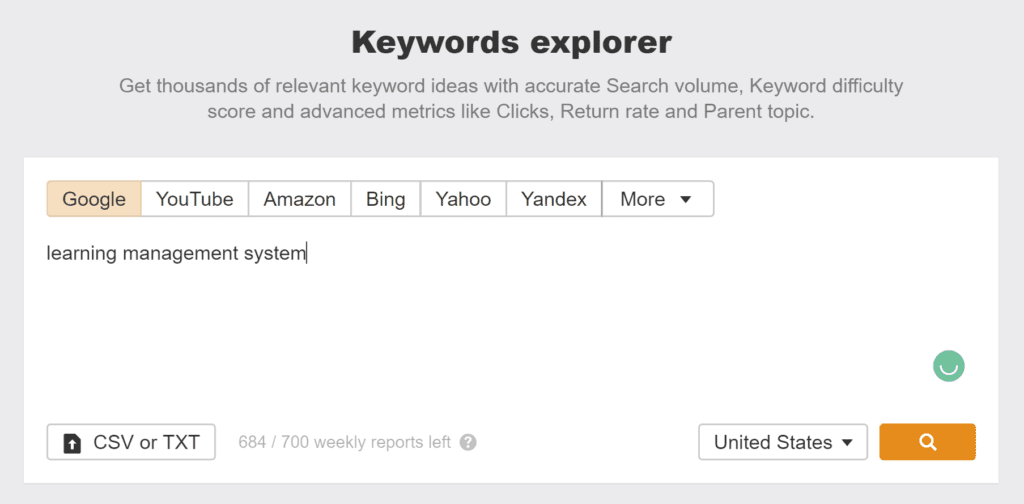
Ahrefs is now going to provide some metrics on this search term, including:
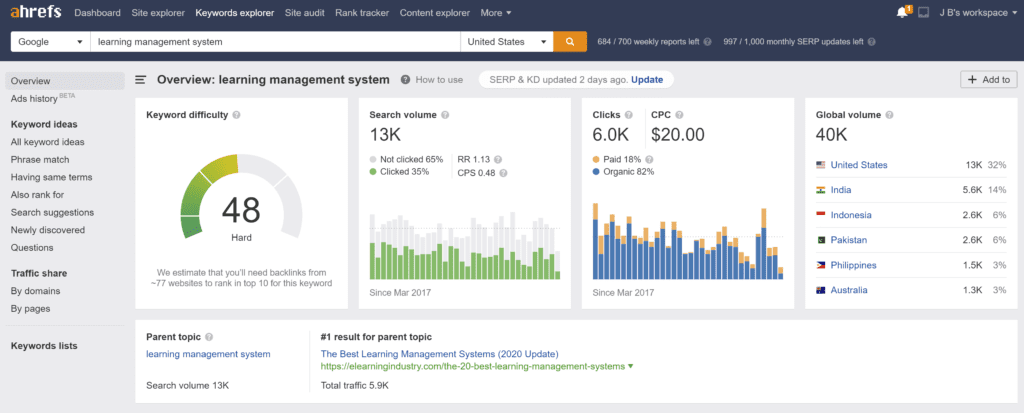
Scroll down a bit on this page, and you’ll find a ton of keywords related to your search query:

You now have over 6,000+ keyword ideas all related to the main keyword “learning management systems.”
Take a look through these by clicking on “View All” and you’ll get a ton of related ideas that you can use as either your primary keyword or as supporting keywords in your content.
Additionally, keep an eye out for long-tail keywords.
These are longer keywords with not a lot of search volume, but normally a lot less competition and often times in the form of a question.
Finding these often uncover customer pain points and adding these to the content creation process can prove to be extremely fruitful.
Sometimes, there’s no reason to reinvent the wheel.
By taking a look at your top competitors, and understanding what they’re already ranking for, you can get a ton of ideas about what’s working for them.
You can then take those keywords, and build content for your own business to steal some of their search traffic.
To do this, simply drop a competitor’s website into Ahrefs:

And click Top Pages on the left-hand menu:

You’ll now have a list of all of your competitor’s top pages that are driving the most search traffic.
This is a great starting point to seeing which keywords and which pages are bringing them search traffic that you can also utilize for your business.
Additionally, you’ll also want to check the Organic keywords tab for your competitors.
Here you’ll find all of the keywords they’re ranking for.
You can also set a filter on this data to see what’s working the best.
Start by looking at keywords that are ranking in position 1-5, and exclude their brand keywords:
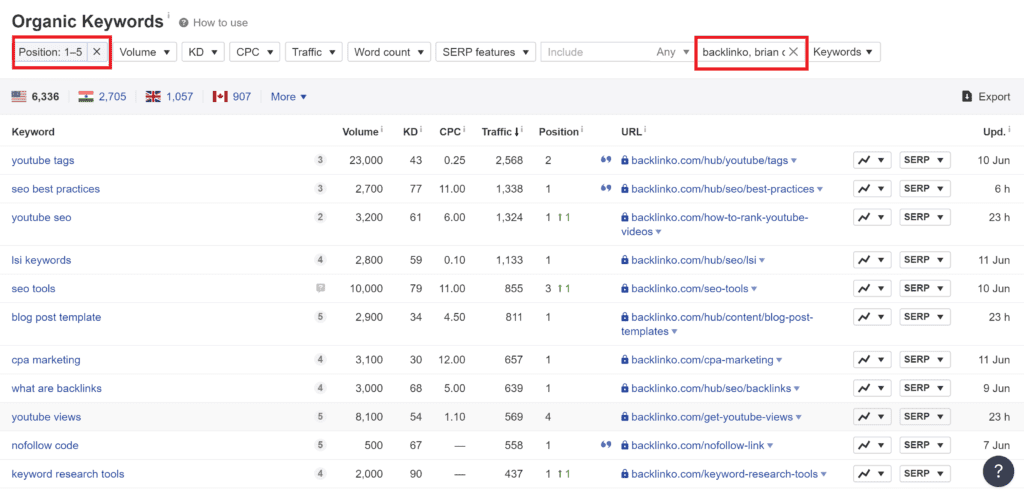
Now that you have a list of keywords built out, you’re going to want to sift through those and find keywords that have the correct intent.
Search intent is what the user has in mind when they’re running a search – what are they exactly looking for?
You’re going to want to group your keywords by intent.
There are three main types of intent behind a keyword:
Let’s take a look at an example to put this into context for a B2B email marketing SaaS company:
It’s important that we understand each of these types of intent, and how they play into the overall B2B content marketing strategy that we implement.
By now, you’ll have a ton of keywords down on paper and you’re ready to start progressing further along in the process.
As you continue to do keyword research, there are a few things to keep in mind:
After conducting keyword research and understanding what your target audience is searching for, it’s time to figure out how you’re going to provide them with what they want.
This is where content strategy comes into play.
For broad search terms, we want to focus on educating the reader with great content that’s both authoritative and in-depth.
Generally, broad searches would include people from different roles searching for general topics such as “email marketing” or “reputation management.”
You want your business to be in front of the target audience for relevant terms, and be the company that is educating them on said topics through great content.
To achieve this, we want to create long-form content (greater than 2,000 words), take a deep dive into the subject and answer important questions that are often asked.
For the most part, the way to do this is by writing an authoritative overview of that topic. It’s a long-form (often more than 2,000 words) dive into the subject, usually answering a few important questions:
This is known as cornerstone content.
You’ll notice across the B2B industry plenty of examples of businesses with great cornerstone content built specifically for the purpose of educating their readers, and ranking for broad search terms:
HubSpot is a CRM platform geared towards marketing and sales, so they wrote a master guide on “What is Digital Marketing” that drives over 11k organic visitors each month:

Sprout Social is a platform which helps business use social media to reach their audience through social media, so they wrote an authoritative piece on “How to improve your social media engagement.”
There are countless examples in the B2B space, of authoritative, educational content with the purpose of helping your audience understand what you can help them with before they purchase your service.
Focused search topics rely on a more narrow approach, and normally cover topics in step-by-step tutorial, case study or listicle fashion.
Strategical content should also be long-form, and go in-depth on recommending expert tips to the searcher’s problem.
Strategical content, on the contrary to cornerstone content, can include contextual links and call-to-actions about how your product or service can help to solve the problem at hand.
You don’t want to go over the top with selling your product, yet at the same time, subtle hints along the way can help spark a searcher’s interest in learning more about your solutions.
Strategical content is great for not only building the trust of your visiting audience but also to pick up links in your industry.
Let’s look at an example:
Super Office is a CRM platform that focuses managing client relationships with connections to major email applications including Exchange, Outlook, Gmail and others.
They created a step-by-step guide titled “The Science Behind Email Open Rates (And How to Get More People to Read Your Emails)“
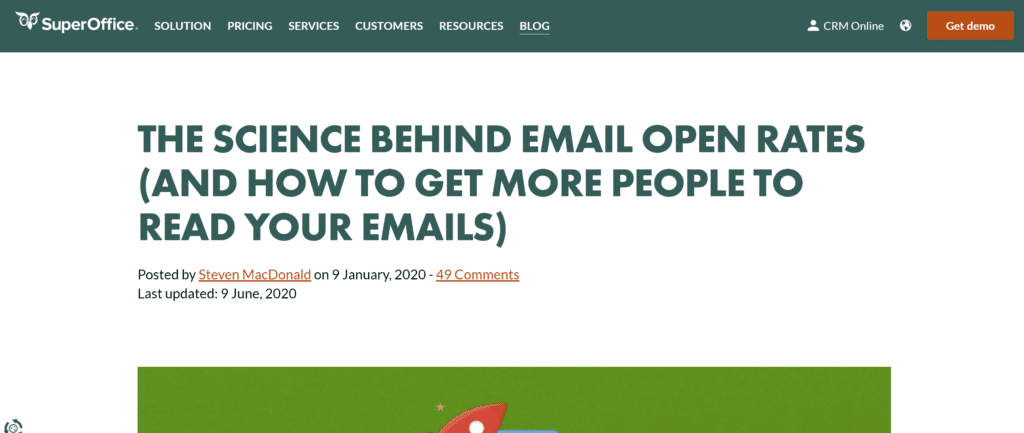
This article alone has achieved the following metrics:

You’ll also notice that the original publish date is from June 2017.
Super Office continually re-visits this content to ensure that it is up-to-date, and keeps adding value to the post over time to help it continue to grow through links, social shares, and traffic.
When you write a great piece that helps to solve a problem, it will be both shared and linked to from both users and other businesses.
Now that we’ve discovered what potential customers are searching for, and we have content that will satisfy customers, we need to focus on how we satisfy Google in order to get our pages to rank in the search results.
There are a few key areas we can start with for the biggest results (think 80/20 rule). As I mentioned earlier, the biggest impact we can make when it comes to B2B organic traffic is by building authority through links, and optimizing our pages for on-page SEO.
Backlinks are essential to ranking high in Google.
Without any domain authority, it’s going to be tough to rank on the first page for any keywords that are even moderately competitive.
If you’re not familiar with how backlinks work, think of with this simple analogy:
Each time a website links to your website that’s considered as a vote.
Each website can only vote one time.
The more votes you get, the higher your site’s value goes in the eyes of Google (better known as domain authority).
The higher your authority, the higher your rankings will increase in the search engine results:
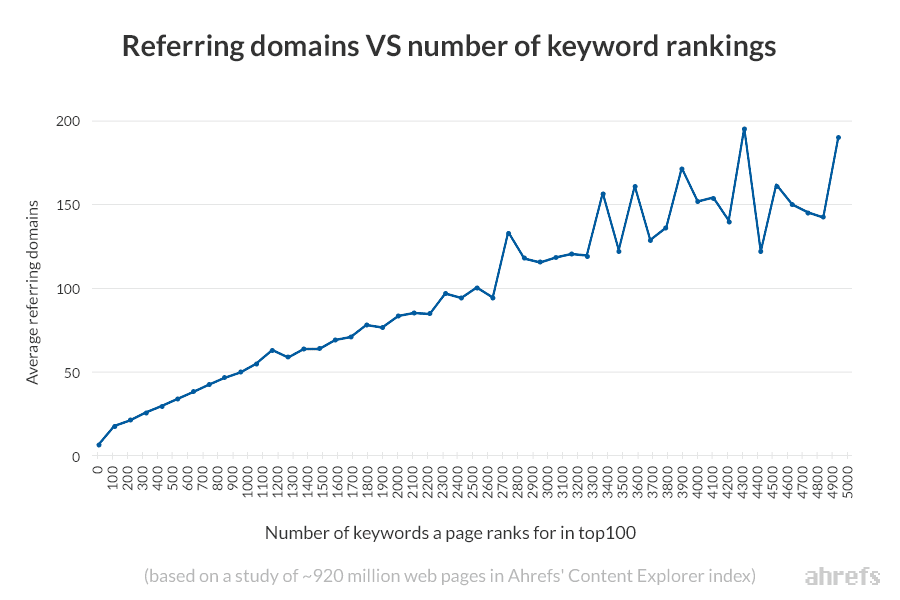
The domain authority of the domain linking to your website also counts.
You want to pick up links from high-authority domains in your industry.
Assuming you’re in the B2B SaaS space, it’s going to be much more beneficial to have 15 high-quality backlinks from the likes of TechCrunch, Hubspot, and so forth than it is from 50 small sites that have no domain authority.
Building links generally requires having linkable assets that others will want to reference in their own content.
By doing in-depth research and studies, and sharing industry-related content that no one else is covering, you can easily pick up a ton of links naturally and through email outreach, contacting influencers, and promoting your content on social channels.
Optimizing existing pages, and also ensuring new content is optimized for SEO is another requirement for doing well when it comes to ranking competitive terms.
If it’s your first time launching an SEO campaign, you’ll really want to dive into the different aspects of on-page SEO to understand what you should be watching for when optimizing a page for B2B search.
Some of the biggest factors you should keep in mind include:
The two most important starting points are your title and meta, as well as supporting keywords in your content.
Meta descriptions and title tags are the first thing searchers will find when they see your page in the search results.
These should be both compelling and contain a call to action.
This is going to increase your click-through rate causing more people to click your result versus others, and in turn, push your page higher in the results.
Additionally, you want to ensure that you’re using supporting keywords in the actual content you’re creating.
This will drive relevancy, let Google understand specifically what you content is about, and also allow you to rank a page for multiple keywords when done properly.
You now have the blueprint for launching your SEO campaign.
If you follow the steps and strategy outlined in this guide, you’ll be on the track to success.
Remember, when it comes down to it, there are really three things to focus on to achieve results in B2B SEO:
When you follow these three rules, you’ll start seeing organic visitors increasing day after day.
Need help implementing a scalable strategy? We’re a B2B SEO agency with real results – let’s discuss.
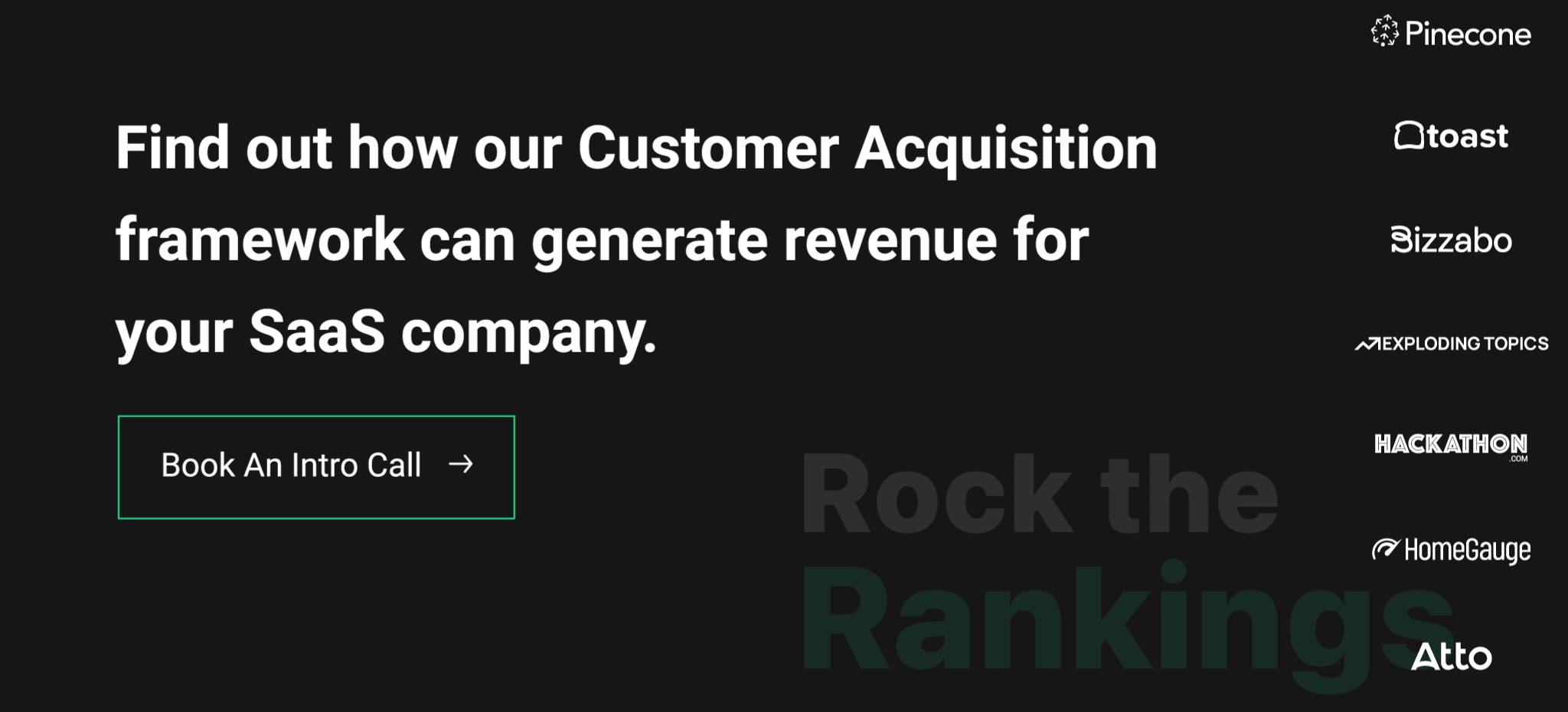
Founder of Rock The Rankings, an SEO partner that helps B2B SaaS brands crush their organic growth goals. An avid fan of tennis, and growing micro-SaaS businesses on the weekend. 2x SaaS Co-Founder – Currently working to build and scale Simple Testimonial.
Book a 1-on-1 intro call with our founder that includes a FREE custom marketing plan. Start growing faster, today.